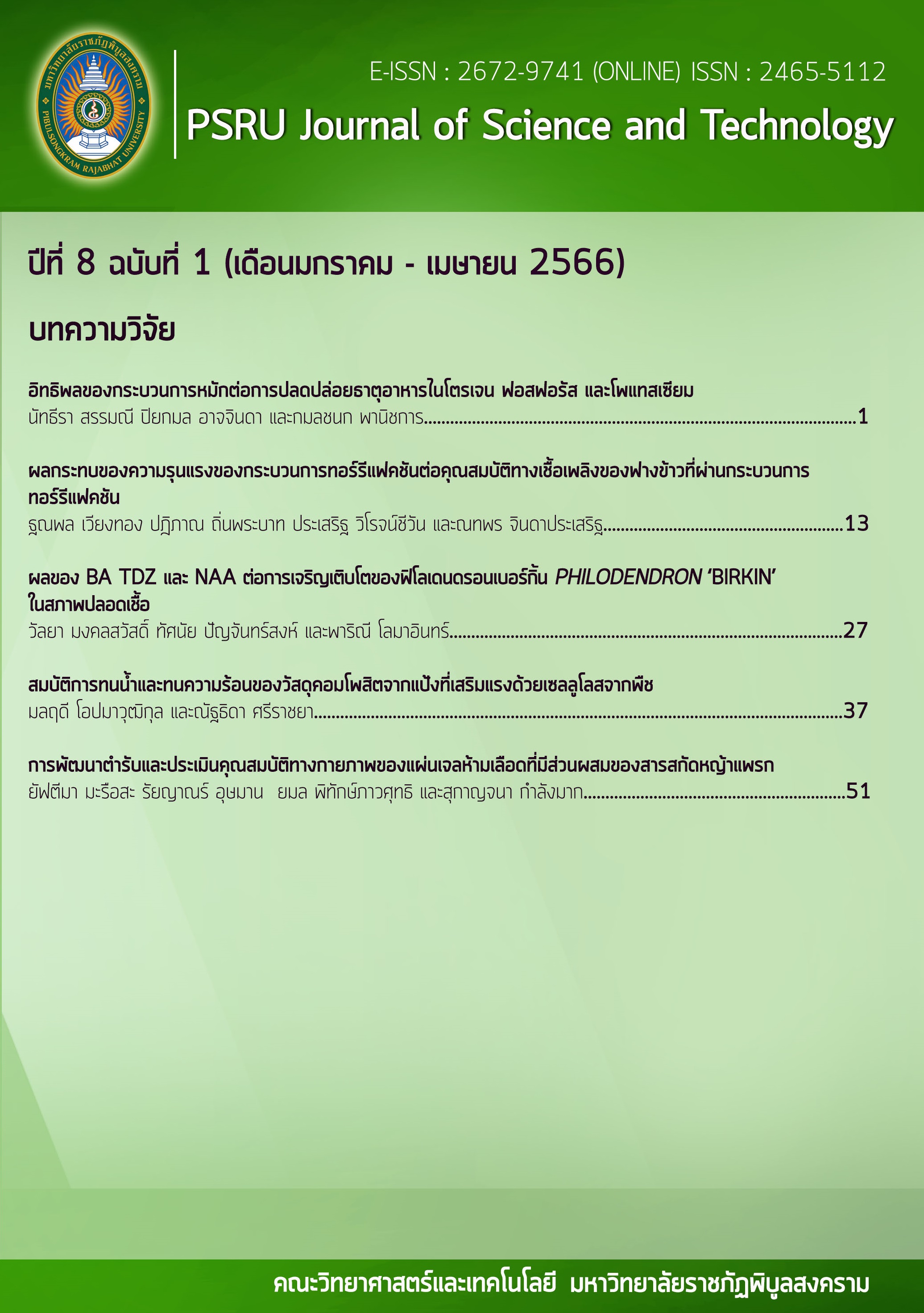EFFECT OF TORREFACTION SEVERITY ON THE FUEL PROPERTIES OF TORREFIED RICE STRAW
Keywords:
Torrefaction, Rice straw, BiomassAbstract
Thailand is an agricultural country with the area of rice cultivation accounting for 51% of the total agricultural area. The rice cultivation yields an agricultural waste, which is rice straw about 35 million tons per year. However, some farmers burn rice straw to facilitate plowing to prepare the soil for planting new crops in the next cultivation season. This is considered a waste of energy and creates air pollution. Therefore, in this research, the improvement of fuel properties of rice straw by torrefaction process to produce energy was investigated using a thermogravimetric analyzer (TGA). The experiment was performed with 10 mg of rice straw at 280 °C with different degrees of torrefaction severity (10, 20, and 30% mass loss). The results show that the torrefaction process can greatly improve the fuel properties of rice straw. Rice straw with the most intense torrefaction process (30% mass loss) has the highest fixed carbon, carbon content and high heating value as well as the lowest humidity content. Therefore, it is suitable to be used for further energy production.
References
เจนจิรา อุตเรือน. (2561). การเพิ่มคุณภาพวัสดุเหลือทิ้งทางการเกษตรด้วยกระบวนการทอร์รีแฟคชัน. (วิทยานิพนธ์ปริญญามหาบัณฑิต). มหาวิทยาลัยแม่โจ้, คณะวิศวกรรมศาสตร์, สาขาวิชาวิศวกรรมพลังงานทดแทน.
บัณฑิต เกิดมงคล, เบญจมาศ อยู่ประเสริฐ, และภรณี ต่างวิวัฒน์. (2556). การไถกลบฟางและตอซังข้าวของเกษตรกร ตําบลตะคุ อําเภอปักธงชัย จังหวัดนครราชสีมา. ใน การประชุมวิชาการแห่งชาติ มหาวิทยาลัยเกษตรศาสตร์ วิทยาเขตกําแพงแสน ครั้งที่ 10 (น. 2894-2902). นครปฐม: มหาวิทยาลัยเกษตรศาสตร์.
สุวัฒน์ เณรโต. (2561). การเพิ่มคุณภาพวัสดุเหลือทิ้งทางการเกษตรด้วยกระบวนการทอร์รีแฟคชัน. (วิทยานิพนธ์ปรัชญาดุษฎีบัณฑิต). มหาวิทยาลัยศิลปากร, คณะวิศวกรรมศาสตร์, สาขาวิชาวิศวกรรมเครื่องกล.
World Bioenergy Association, W.B. (2021). Global bioenergy statistics 2021, Retrieved February, 10, 2023, from https://www.worldbioenergy.org/uploads/211214%20WBA%20GBS%202021.pdf.
Bergman, P.C.A., & Kiel, J.H.A. (2005). Torrefaction for biomass upgrading. Proc. 14th European Biomass Conference, Paris, France, (October), 17–21.
Boudot, M., Elettro, H., & Grosso, D. (2016). Converting water adsorption and capillary condensation in usable forces with simple porous inorganic thin films. ACS Nano, 10(11), 10031–10040.
Bridgeman, T.G., Jones, J.M., Shield, I., & Williams, P.T. (2008). Torrefaction of reed canary grass, wheat straw and willow to enhance solid fuel qualities and combustion properties. Fuel, 87(6), 844–856.
Cahyanti, M.N., Doddapaneni, T.R.K.C., & Kikas, T. (2020). Biomass torrefaction: An overview on process parameters, economic and environmental aspects and recent advancements. Bioresource Technology, 301, 122737.
Caillat, S., & Vakkilainen, E. (2013).Biomass Combustion Science, Technology and Engineering.Cambridge: Woodhead Publishing.
Campbell, W.A., Coller, A., & Evitts, R.W. (2019). Comparing severity of continuous torrefaction for five biomass with a wide range of bulk density and particle size. Renewable Energy, 141, 964–972.
Chaloupková, V., Ivanova, T., Hutla, P., & Špunarová, M. (2021). Ash melting behavior of rice straw and calcium additives. Agriculture (Switzerland), 11(12), 1–12.
Chen, W.H., Lin, B.J., Lin, Y.Y., Chu, Y.S., Ubando, A.T., Show, P.L., & Pétrissans, M. (2021). Progress in biomass torrefaction: Principles, applications and challenges. Progress in Energy and Combustion Science, 82, 100887.
Cremers, M., Koppejan, J., Sokhansanj, S., Melin, S., & Madrali, S. (2015). Status overview of torrefaction technologies, Retrieved February, 10, 2023, from https://www.ieabioenergy.com/wp-content/uploads/ 2015/11/IEA_Bioenergy_T32_Torrefaction_update_2015b.pdf.
Cruz Ceballos, D.C., Hawboldt, K., & Hellleur, R.(2015).Effect of production conditions on self-heating propensity of torrefied sawmill residues. Fuel, 160, 227–237.
García, R., Pizarro, C., Lavín, A.G., & Bueno, J.L. (2012). Characterization of Spanish biomass wastes for energy use. Bioresource Technology, 103(1), 249–258.
García, R., Pizarro, C., Lavín, A.G., & Bueno, J.L. (2013). Biomass proximate analysis using thermogravimetry. Bioresource Technology, 139, 1–4.
Granados, D.A., Ruiz, R.A., Vega, L.Y., & Chejne, F. (2017). Study of reactivity reduction in sugarcane bagasse as consequence of a torrefaction process. Energy, 139, 818–827.
Ilham, Z.(2022).Biomass classification and characterization for conversion to biofuels. Value-Chain of Biofuels, 69-87.
Romão, E.L., & Conte, R.A., (2021). Energy gains of eucalyptus by torrefaction process. Maderas: Ciencia y Tecnología, 23(3), 1–6.
Nhuchhen, D.R., & Afzal, M.T. (2017). HHV predicting correlations for torrefied biomass using proximate and ultimate analyses. Bioengineering, 4(1), 7.
Nunes, L.J.R., Matias, J.C.O., & Catalão, J.P.S. (2014). Mixed biomass pellets for thermal energy production: A review of combustion models. Applied Energy, 127, 135–140.
Pachauri, N., Rani, A., & Singh, V. (2017). Bioreactor temperature control using modified fractional order IMC-PID for ethanol production. Chemical Engineering Research and Design, 122, 97–112.
Prins, M.J., Ptasinski, K.J., & Janssen, F.J.J.G. (2006). Torrefaction of wood. Part 2. Analysis of products. Journal of Analytical and Applied Pyrolysis, 77(1), 35–40.
Rousset, P., Aguiar, C., Labbé, N., & Commandré, J.M. (2011). Enhancing the combustible properties of bamboo by torrefaction. Bioresource Technology, 102(17), 8225–8231.
Sabil, K.M., Aziz, M.A., Lal, B., & Uemura, Y. (2013). Synthetic indicator on the severity of torrefaction of oil palm biomass residues through mass loss measurement. Applied Energy, 111, 821–826.
Vassilev, S.V., Vassileva, C.G., & Vassilev, V.S. (2015). Advantages and disadvantages of composition and properties of biomass in comparison with coal: An overview. Fuel, 158, 330–350.
Wang, C., Peng, J., Li, H., Bi, X.T., Legros, R., Lim, C.J., & Sokhansanj, S. (2013). Oxidative torrefaction of biomass residues and densification of torrefied sawdust to pellets. Bioresource Technology, 127, 318–325.
Wang, M.J., Huang, Y.F., Chiueh, P.T., Kuan, W.H., & Lo, S.L. (2012). Microwave-induced torrefaction of rice husk and sugarcane residues. Energy, 37(1), 177–184.
Wigley, T., Yip, A.C.K., & Pang, S. (2016). Pretreating biomass via demineralisation and torrefaction to improve the quality of crude pyrolysis oil. Energy, 109, 481–494.
Zhang, C., Yang, W., Chen, W.H., Ho, S.H., Pétrissans, A., & Pétrissans, M. (2022). Effect of torrefaction on the structure and reactivity of rice straw as well as life cycle assessment of torrefaction process. Energy, 240, 122470.
Downloads
Published
Versions
- 2024-05-29 (2)
- 2023-04-21 (1)
How to Cite
Issue
Section
License
Copyright (c) 2023 PSRU Journal of Science and Technology

This work is licensed under a Creative Commons Attribution-NonCommercial-NoDerivatives 4.0 International License.
กองบรรณาธิการขอสงวนสิทธิ์ในการปรับปรุงแก้ไขตัวอักษรและคำสะกดต่างๆ ที่ไม่ถูกต้อง และต้นฉบับที่ได้รับการตีพิมพ์ในวารสาร PSRU Journal of Science and Technology ถือเป็นกรรมสิทธิ์ของคณะวิทยาศาสตร์และเทคโนโลยี มหาวิทยาลัยราชภัฏพิบูลสงคราม และ
ผลการพิจารณาคัดเลือกบทความตีพิมพ์ในวารสารให้ถือมติของกองบรรณาธิการเป็นที่สิ้นสุด







